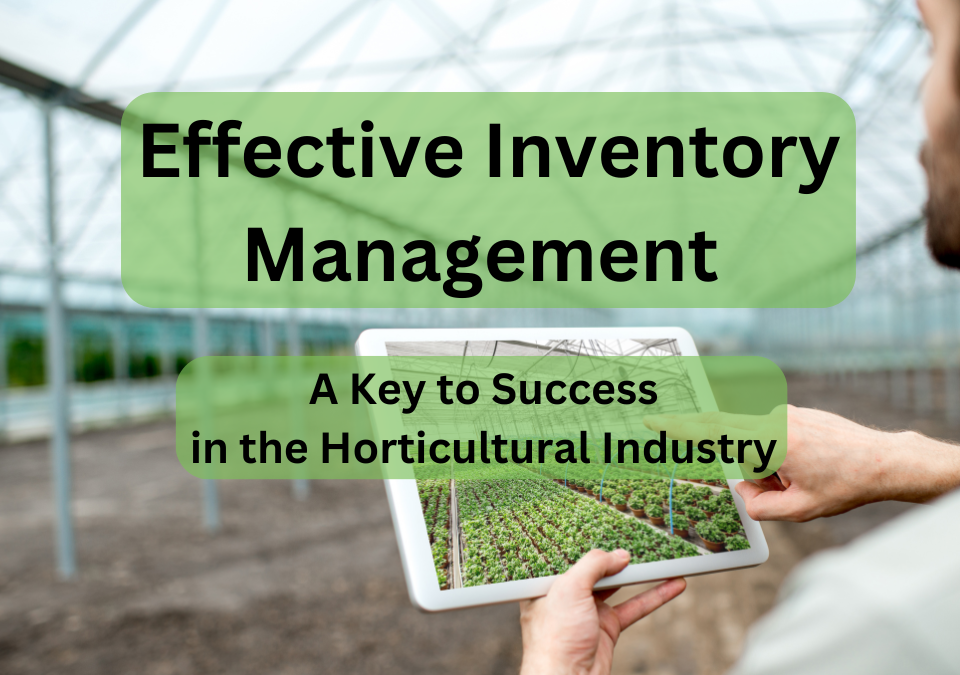
Cultivate ’24 – Forecasting Workshop Announcement
March 4, 2024
Did You Pay Too Much for a Nursery/Greenhouse Software?
March 26, 2024This is a an AGS Guest Expert Blog post by Tim Kilgore. Tim has broad and deep experience for a variety of capacities in the horticultural industry. Currently, as a Sales Representative at McHutchison, he leverages his deep industry experience, dynamic interpersonal skills, and proactive approach to foster enduring and committed client partnerships.
In the fast-paced world of horticulture, where seasons change and demand fluctuates, one thing remains constant: the importance of a good inventory system. As I like to say, “Everything starts with a good inventory.” Yet, in my travels within the industry, I’ve observed a surprising underutilization of effective inventory management systems, particularly among wholesale nurseries, garden centers, and large landscape contractors.
What is Effective Grower Inventory Management?
Effective inventory management is not just about keeping track of plants and products; it’s about staying organized and responsive to market trends. It provides critical data that empowers businesses to make informed decisions, avoid supply chain breakdowns, and maintain profitability. But implementing the right inventory system isn’t a one-size-fits-all solution; each company must tailor its system to fit its unique needs and circumstances.
Tracking inventory with outdated methods like pen and paper or relying on memory can seriously hinder a business. Every minute spent searching for an item in the nursery or manually counting inventory every time you get a call, is time wasted and productivity lost. Customers expect efficiency, and if they can’t find what they need, they’ll simply move on to the next supplier.
Effective inventory management involves a range of processes, from receiving and organizing inventory to monitoring levels, forecasting demand, and replenishing stock as needed. It’s about optimizing inventory levels to reduce costs, minimize storage needs, and improve cash flow. A well-managed inventory system not only satisfies customers with having the right inventory but also helps businesses anticipate and capitalize on sales trends.
How Can Effective Inventory Improve a Grower Operation?
By analyzing inventory data, companies can identify inefficiencies and make strategic decisions about which products to stock, promote, or discontinue. This data-driven approach enhances decision-making and gives businesses a competitive edge in the market.
Furthermore, efficient inventory management can boost employee productivity by streamlining processes and reducing time spent on manual tasks. With the right training and support, employees can focus on more value-added activities, contributing to the overall success of the business.
In the horticultural industry, inventory isn’t just limited to finished products; it also includes production inventory and supplies essential for daily operations. A robust inventory management system provides management with the information needed to make informed decisions about production, sales, and demand trends.
While smaller operations may rely on simple inventory systems, larger commercial nurseries and greenhouses may require more sophisticated systems that are updated daily. Regardless of size, the key to success lies in maintaining accurate sales inventory and ensuring that employees are properly trained to utilize the system effectively.
Conclusion
Effective inventory management is essential for the long-term success of any business in the horticultural industry. By investing in the right systems, tools, and employee training, businesses can optimize inventory levels, improve cash flow, enhance customer satisfaction, and gain a competitive advantage in the market. As I like to remind everyone, “Everything starts with a good inventory.”
Author
-

Tim Kilgore brings 25 years of seasoned expertise in the landscape horticulture industry across Michigan, New Jersey, and Pennsylvania. His rich background spans from retail sales to wholesale distribution, operations management to marketing, and landscape contracting. Currently as a Sales Representative at McHutchison, he leverages his deep industry experience, dynamic interpersonal skills, and proactive approach to foster enduring and committed client partnerships.




